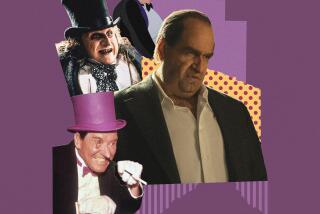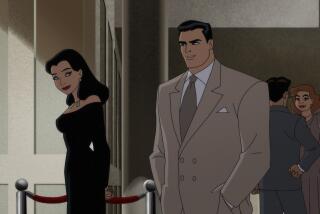Watching as Batman takes wing
When “Batman” first appeared in 1939 under the aegis of DC Comics (Detective Comics), comic books were the bastard child of comic strips. Early comic books were reprints of syndicated strips -- daily and Sunday comics tossed between covers -- and the success of DC’s original-material comics was unexpected. Today, syndicated adventure strips might be considered dinosaurs, but at the dawn of comic books, syndicated strips roamed and ruled the newspaper world -- Milton Caniff (“Terry and the Pirates”), Alex Raymond (“Flash Gordon”) and Chester Gould (“Dick Tracy”) were the idols of aspiring young cartoonists.
The creators of “Superman,” Jerry Siegel and Joe Shuster, were a couple of teenagers from Cleveland who would be repaid for coming up with the great symbol of “truth, justice and the American way” by losing their character, rights and all, for a mere $130. Bob Kane, at 22 a little older and wise enough to get a better contract, would see his creation, “Batman,” bring him fame and money for many decades. Some comics historians credit Kane’s primary writer, Bill Finger (21 when “Batman” began), as the co-creator of the strip, but his contributions remain murky.
“Superman” was a comic-strip concept that every syndicate in the country had turned down: Having it appear in a low-end comic book was a last resort, even for a couple of teenagers. But the surprise success of the feature in Action Comics led DC to encourage other creators to come up with costumed heroes. Kane’s response was to develop “Batman,” a modern-day version of Johnston McCulley’s “Zorro,” with elements of various pulp-magazine heroes thrown in.
With the “Batman” movie franchise poised to reinvent itself yet again with “Batman Begins,” the expected flurry of comics material, new and old, rushes to the shelves. Two reprint volumes are of particular interest -- “The Batman Chronicles: Volume One,” which collects tens of thousands of dollars’ worth of rare late-1930s and early-’40s comic books into one modestly priced package; and “Batman: Year One,” Batman’s beginnings as seen by the character’s most influential contemporary interpreter, Frank Miller.
The difference between the two is as striking as a Miller visual (although Miller himself does not draw “Batman: Year One” -- that’s left to the brilliant David Mazzucchelli). And “Chronicles” represents the better bargain -- four 1980s comic books can hardly compare in collectibility to the original Batman stories as seen in Detective Comics No. 27 (May 1939) through No. 38 (April 1940) and the priceless Batman No. 1 (Spring 1940).
Yet it’s fair to say that only collectors and pop-culture buffs will prefer “Chronicles” over Miller’s dark vision. Anyone under 25, knowing only the film franchise, may be astounded by the crude, juvenile nature of the source material; even a generation or so of fans of DC’s “Batman” comics and graphic novels may find bewildering the amateurish nature of Batman’s real beginnings.
The first story in “Chronicles” (Detective Comics No. 27) is crudely drawn, almost childish in Kane’s strained technique combining Gould and Caniff. The story is a pale shadow of low-end B movie plots with some radio-serial nonsense tossed in. But the raw outlines of the concept can be made out: Commissioner Gordon and Bruce Wayne are present, as is a fiendish villain. The art style is largely “Dick Tracy” -- geometric, though a hint of the gothic comes when Batman is silhouetted against the moon. Still, “Rob’t Kane” is clearly a beginner.
Both Kane and Batman improve, however, and fairly quickly. By the next issue, Batman is using “a tough silk rope [drawn] from his belt” to swing between skyscrapers, and the artwork is cleaner and better designed, and the writing slightly less redundant. But the plotting remains simultaneously simplistic and incoherent: Batman leads the police to assume he’s a jewel thief “so that the [real] jewel thieves would think they weren’t being watched.” By Detective No. 29, Kane is providing a nicely designed (if perspective-impaired) cover, stylish and evocative with bats against the moon and a “mad scientist” castle. And Batman starts using gadgets -- gas pellets from the as-yet-unnamed utility belt, as well as suction gloves and, embarrassingly, kneepads.
Kane seems an increasingly confident artist, but the writing remains redundant, a caption telling us: “The Batman is in his car,” which is exactly what the panel depicts, as if the script’s descriptions have been accidentally included, like Carl Reiner’s actor who thinks his first line is “Enter laughing!”
As the issues progress, however, the art grows moodier, the covers particularly strong, the action tough -- Batman even breaks a bad guy’s neck, and frequently uses a gun (soon to be forbidden in the feature). New York has not yet been renamed Gotham City, but (by DC No. 31) Batman’s gadgets have acquired their familiar prefix: Batarang, Batgyro, Batplane.
The gothic mood is heightened by more detailed inking, and stories are at times supernatural -- Batman kills a vampire with a silver bullet (not a wooden stake), while a monster climbs the Empire State Building, doing a King Kong impression. Wisecracks during fight scenes have now joined the Bat-format -- “Let’s pretend I’m the ball and you’re the bowling pins!” -- with the fights themselves better staged, panels expanding to accommodate the action.
The Chester Gould influence remains strong, with a character modeled on the faceless “Tracy” villain, the Blank, in Detective Comics No. 34. A far more important “Tracy” influence is the introduction of Dick Grayson, a.k.a. Robin the Boy-Wonder. If Batman is Dick Tracy in costumed-hero drag, then Robin is Tracy’s adopted son, Junior, similarly attired. Much has been written about the introduction of Robin lowering the strip from its “serious” beginnings, but anyone reading the early stories knows that the audience being sought was a juvenile one, and a kid sidekick was a smart, commercial addition.
By the time spinoff comic book Batman No. 1 rolls around, Kane -- with help from assistants Sheldon Moldoff and Jerry Robinson (a teenager) -- has blossomed into an eccentric success. Key villain the Joker appears in two stories, and Catwoman makes her first appearance too. The post-Robin Batman remains tough, killing a bad guy with a machine gun: “Much as I hate to take a human life, I’m afraid this time it’s necessary!”
“The Batman Chronicles” is wall-to-wall Bob Kane, but the young cartoonist would do increasingly little on his bylined feature, leaving the work to assistants and ghosts, preferring to draw a syndicated-strip version. Siegel and Shuster did the same, jumping ship for the respectable world of comic strips.
Comic books began as a second-class pop-culture citizen, and to this day retain a certain stigma. The notion that comics are juvenile allowed crackpot psychiatrists and McCarthyite censors to water down the entire comics medium in the early ‘50s, the industry adopting its own restrictive code. “Superman” and “Batman” endured through those years, having generated enough spinoffs to retain a pop-cultural foothold. When in the early ‘60s Marvel reinvented the juvenile superhero form for adolescent readers, DC also flourished, having already floated revamped versions of its ‘40s costumed heroes.
But it’s unlikely that “Batman Begins” and the rest of the movie franchise would have had a chance without the “Batman” TV show. Reviled by most comic-book fans, the mid-’60s “Batman” series played off the Andy Warhol-driven Pop Art phenomenon in all its colorful POW! ZAP! glory, a live-action comic book that could be enjoyed straight by children, while teenagers and adults laughed at the campiness of Batman brought to long-john-wearing life. Yet the “Batman” TV series was faithful to its source, adapting stories from the comic book and using the major villains. Adam West played Batman in a deadpan manner -- only the context went for laughs.
Still, anyone who reads comic books doesn’t need to be further made fun of, and the show itself seemed an insult to fans. So the “Batman” comic books that followed the TV series aimed at removing the camp as writer Denny O’Neil and illustrator Neal Adams depicted a frightening gothic Gotham City and a driven hero. But it was Frank Miller’s “The Dark Knight Returns” in 1987 that created the modern, determinedly serious version that fueled Tim Burton’s “Batman” in 1989 and the movies that followed.
Which brings us to “Batman: Year One.” This reprint of four issues from 1987 will please many readers, and rightly so. The artwork by Mazzucchelli -- from the Milton Caniff school by way of Alex Toth (“Zorro”) and Doug Wildey (“Jonny Quest”) -- may be the best “Batman” has ever had. As for Miller, his characterization of Batman-Bruce Wayne is intelligent and convincing, and his ability to mount an action scene is second to none.
My problems with this latter-day Batman, specifically -- and the latter-day Batman character in general -- is a basic wrongheadedness in approach. Batman was created by kids for kids, a juvenile fantasy embraced by adolescents of all ages. Making a realistic, “adult” version is fundamentally foolish, even silly: Catwoman is a prostitute; Commissioner Gordon cheats on his pregnant wife. Miller’s Gotham City is as angst-driven and unpleasant as his own Sin City. Further, his Mickey Spillane-influenced purple prose steps on his artist, intruding with overwrought introspection.
None of this prevents “Batman: Year One” from being an interesting, entertaining update, particularly if read quickly -- and not taken as seriously as Miller seems to. As for “The Batman Chronicles,” I can only hope that new readers will see the childish, formative art and clumsy stories as a work in progress, and that they’ll look forward to future volumes of “Chronicles,” which will reprint the work of the best of Kane’s ghosts, Dick Sprang, whose clean, glossy artwork of the 1950s brought the class of a syndicated strip to the bastard Bat-child. *
More to Read
The biggest entertainment stories
Get our big stories about Hollywood, film, television, music, arts, culture and more right in your inbox as soon as they publish.
You may occasionally receive promotional content from the Los Angeles Times.










